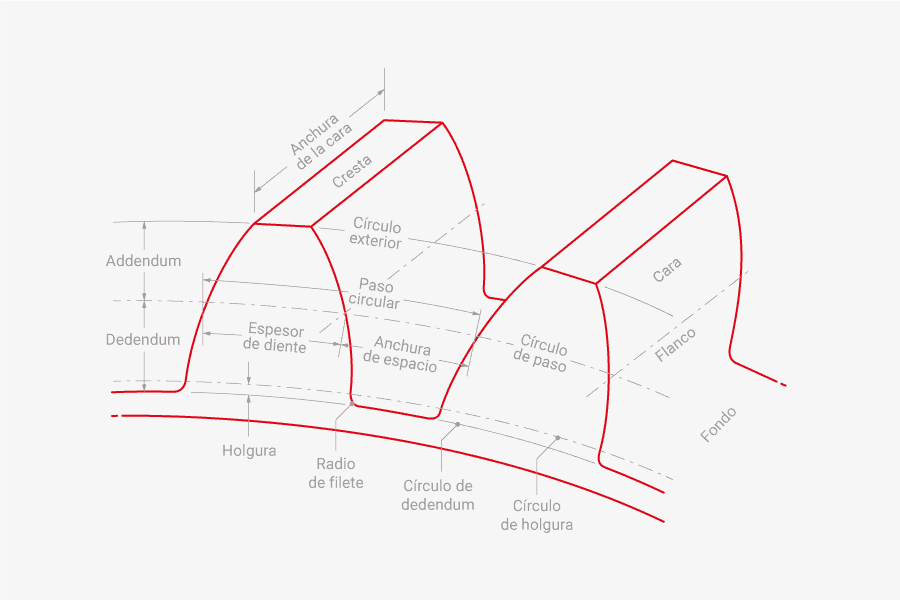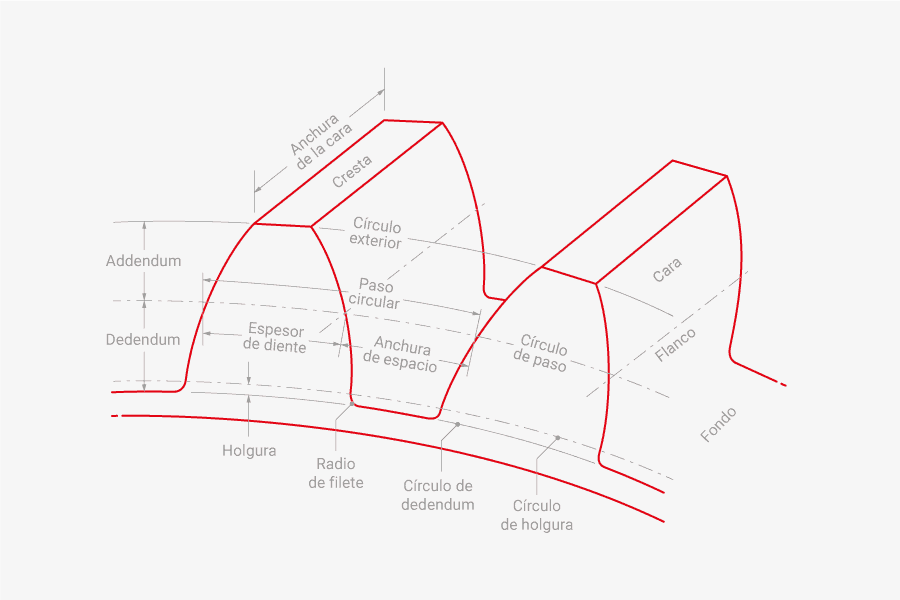
Los gears or racks they are devices made up of toothed wheels that serve to transfer mechanical power between two elements. They are commonly used in the machines that are used in many industrial processes, such as production chains and automotive systems, but also in sectors as diverse as mining, aeronautics, the pharmaceutical industry or the textile industry. The needs for which they are manufactured are those that determine the design of the gears (conical gears, straight tooth gears, helical gears...) and also their materials.
Gears are used massively because They have great advantages:
- They take up much less space
- They offer a high capacity to transmit power
- They have high performance
- The maintenance they require is very basic
- Eliminate any chance of slipping
In this article, we will focus on What is a conical gear and how does it work, so that we understand their functions and learn to choose the most suitable ones for our project.
Free ebook: Gear calculation: Improve efficiency in your transmissions
Characteristics of a conical gear
Los conical gears are those that use two conical toothed wheels to transmit power between axes that cut within the same space; although gears known as hypoidal are capable of transmitting power between two intersecting axes.
La The shape of the teeth of a conical gear can be Straight or helical, which is also known as a conical propeller. The different types of gears can be classified according to the characteristics of the width of their teeth, but also the width of the face or the central circular passage.
The following graphic shows the Nomenclature of gears and its parts:

Types of Bevel Gears
There are different types of bevel gears, depending on the shape of the teeth, which we will learn about below:
Helical shaped conical gear
By combining right and left propeller, this type of gear is used for transmit a movement between axes that cut in the same plane. Therefore, they reduce the speed reached by an axis to 90 degrees.
They are commonly used in rear axle transmissions for vehicles motorised and stand out because they barely generate sound.
The main difference compared to spur gears is that the edges of the teeth are not parallel to the axis of rotation, but are positioned at an angle.
Hypoid-type conical gear
It is less common and can be considered a type of helical conical gear, although the difference is that these devices are formed by a reduction pinion, with few teeth, and a wheel which has a large number of teeth.
They are used for situations where the axes are perpendicular, but they do not lie within the same plane.
In addition to industrial machinery, its use is common in the automotive industry, which uses it in rear-wheel drive vehicles to establish the connection between the driveshaft and the wheels. They use a type of oil that is characterized by its high pressure.
You might be interested in: Main actuators in automotive
Straight tooth conical gear
Your straight teeth are presented on surfaces with conical characteristics thanks to a milling on its outer surface.
They are useful for verifying the transmission of motion that occurs between those axes that cut within the same plane, almost always at an angle of 90 degrees.
Although they are only used for get a speed reduction on 90-degree axes, they may also work at scales of 45, 60, or 70 degrees. Unlike helically shaped bevel gears, they use little contact surface.
Spiroidal conical gears
The peculiarity of these conical gears is that they operate in very pronounced and different planes.
They stand out for their coupling, since the teeth of the pinion are wider than those of the crown.
This makes it easier for them to Transmit very high torques without causing wear and tear, since the teeth of the sprocket are attached to the different teeth of the crown.
What are bevel gears used for
Each type of conical gear is usually used to perform specific operations:
Straight tooth conical gears
Although they are somewhat obsolete compared to other types of gears, in part due to the noise they make during start-up, straight tooth bevel gears still have many uses in watches, dental drills, hand drills or vending machines.
They are still used, as well, in certain sectors such as material handling, etc. It is common to see them in food packaging and canning equipment, lawn and garden equipment, machines such as lathes and cutters, compression systems for oil and gas markets, and fluid control valves.
Spiral conical gears
These gears have a modified tooth design. Conical sprockets are used in situations where it is important change the direction of rotation of the axes.
In conical spiral sprockets, the teeth curve to provide a more gradual gearing and greater contact tooth to tooth than on a straight conical sprocket.
In this way Vibration and noise are reduced which is usually the result of the movement of both spur and other spur gears at high speeds.
Related Reading: Guide to avoiding annoying noises and vibrations in your reducers
Spiral conical sprockets provide a high level of control over tooth contact, and its design allows for certain mounting deflections without placing excessive load stress on either end of the teeth.
Since they can be used at high speeds, they are often used in motorcycle and bicycle gears.
Conical hypoidal gears
Hypoidal conical gears are used, in many cases, at which time Speeds exceed 1,000 revolutions per minute.
Despite this, they are also useful for low speed applications that require extreme smoothness of movement or quiet operation.
In multistage gearboxes, hypoid gears are often used for exit stage, where lower speeds and higher torque are required.
The most common application of hypoid gearboxes is in automotive industry, where they are used on rear axles, especially for large trucks.
Its angles, spiraling to the right in the crown and to the left in the pinion, achieve a “below center” shift. This allows the driveshaft to be placed in a lower space, which in turn affects a lowering of the vehicle's center of gravity and does not interfere so much with the passenger compartment.
Real applications of bevel gears
Bevel gears are used in a huge variety of applications, ranging from those used in the mining sector (wheel excavators, stacker and collector drives, dredging, mill drives, belt conveyors, etc.) to the aerospace sector (high speed straight and spiral bevel gears, special steels and processes, air preheater, etc.).
They are also common in cone crushers and sand mixers, forklifts, cooling towers, drives and propellers for ships, high-speed offset printing, pharmaceutical packaging machines, polyethylene sheet production or automotive transmissions and railways.
In the field of robotics angular conical gears are used for tight spaces, while in the steel industry they are used in angular gluing mills or vertical supports of rolling mills.
As for the food processing, conical gears play a fundamental role in food packaging and processing and can-making equipment.
Now that you know all the uses and characteristics of bevel gears, you may want to go a step further and start applying them to your own projects.
Do you need more information when choosing the type or types of bevel gears for your projects? Contact us and our team of experts will advise you to choose the best gears for your plans.

We offer customized, tailor-made solutions. Configure with us the perfect gearmotor for your project.
¿Tienes un proyecto en mente?
We can manufacture your tailor-made solution, we accompany you at every stage of the project to offer the solution that best suits your application.
Do you have a project in mind?
We can manufacture your tailor-made solution, we accompany you at every stage of the project to offer the solution that best suits your application.








